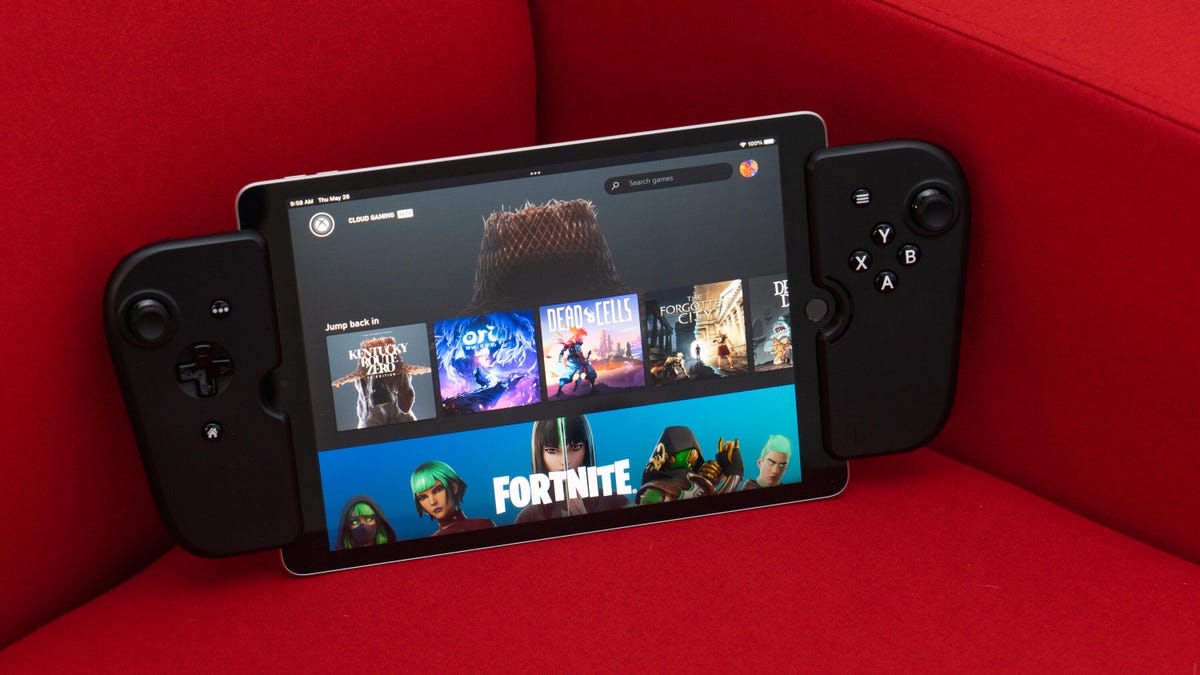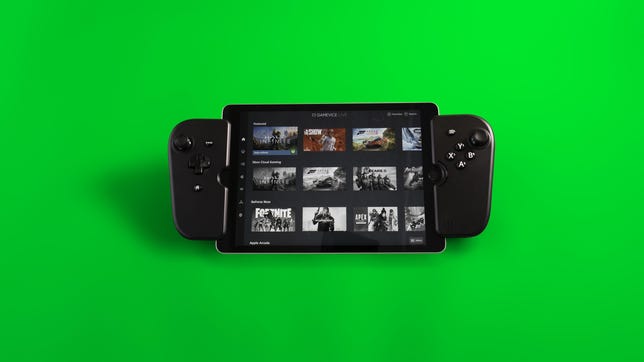 Why You Can Trust CNET
Why You Can Trust CNET Gamevice for iPad Review: A Better Idea Than You'd Think
Using a split-sided game controller on an iPad seems as awkward as using the tablet for street photography. But it's not as cumbersome as it sounds.

At first glance, Gamevice's Lightning-compatible (MFi) controller for the iPad tablet looks like an absurdly large gaming device. But while the Gamevice for iPad does turn the tablet into a large mobile gaming console, it's actually pretty comfortable for seated, lean-back style games. And an iPad's much-larger screen is better for cloud gaming, since many of the games are designed for big screens and don't scale well to phone size -- especially if you have bad or age-degraded vision.
The Gamevice for iPad isn't cheap at $100 (about £79 and AU$139, directly converted), but at the moment the company offers the only solutions for Nintendo Switch or Valve Steam Deck-like designs, with a split controller mounted on both sides of a screen. It can only be used directly attached that way; you can't connect the two sides of the controller together and use it standalone, as you can with some. If you're familiar with the Razer Kishi, the Gamevice's iPad and iPhone controllers are very similar; unsurprising, since Gamevice worked with Razer on that device.

Gamevice for iPad
Like
- A nice solution for certain styles of iPad gaming
- Passthrough Lightning connector for power
- Not too big for medium hands, despite the extended length of the grips
Don't like
- Expensive
- Grips are slippery
- Buttons and triggers feel somewhat mushy
- iPad connection can be wonky
- Can't be used standalone
It supports any Lightning-based iPad, including the iPad (5th to 9th-gen versions), iPad Air 2 and iPad Air 3, the iPad Pro 9.7-inch and iPad Pro 10.5-inch. I tested it with the current 9th-gen model; I tried it on a 7th-gen iPad, but the tablet tended to crash with the controller. Gamevice says that it's working on a USB-C version as well for those of us with newer iPad Airs, Minis or Pros.
An elastic band stretches between the two halves to help support the iPad.
Attaching the controller to the iPad works much like the Kishi. Its two sides are connected by a thick elastic band and the iPad slips into rubberized grooves on both sides. The right side pops over and connects to the Lightning port. There's a passthrough Lightning connector on it so you can charge the iPad, but it doesn't support audio because Lightning's just not that smart. The controller itself is powered by the iPad battery, and it seems to consume only a minimal amount. It's easy to pop on and off, a plus since you probably won't want to leave it on full-time.
By necessity, the grips are pretty large, though not too large for my medium-size hands.
Although the Gamevice is an official "Designed for Xbox" accessory, it doesn't have a standard Xbox controller layout. Rather than the left thumbstick close to the top and the right close to the bottom, they're both towards the top, which also means the ABXY buttons sit below and to the left of the right thumbstick. It can take a little getting used to.
Given how much taller the Gamevice for iPad is than typical controllers, it's surprising how little I felt the need to stretch to reach anything. That seems to be because most of the extra length extends toward the bottom, so that all hands grip within reach of the controls and smaller hands just have more of it to rest on.
It probably would get tiresome to hold like a smaller mobile console or phone -- at least, I find it awkward given the size. But sitting up in bed with my knees bent and the iPad resting on my legs is my preferred position for gaming on a phone or iPad, and it's a perfect design for that. I tend not to play speed-intensive games on my mobile devices, though. If you play games that require fast reflexes, that's not a great position.
If you've got serious Xbox muscle memory, the right side's control layout may trip you up.
I think there are probably things that may take more work to get used to, though. The grips are matte but quite slippery, and I suspect they'll get more so over time. You can probably compensate with some grip tape, though. The nonstandard shape and size of the grips means there's no precut grips you can use.
My biggest gripe with the physical design, though, is how mushy its buttons and triggers are. It doesn't really matter how much Lightning reduces latency over Bluetooth connections if the controls don't operate crisply, since you then can't tell which is responsible for the response lags. "Mushy" is in the fingers of the player, though, so you might find it to your taste.
The controller also gave me intermittent connection issues between services. In other words, it would work fine in Xbox Cloud Gaming, but if I jumped to GeForce Now the games couldn't see it. Restarting the iPad would fix that, but then switching to another service wouldn't work. And Google Stadia just didn't see the controller at all, though I didn't take the time to dig in to diagnosing the problem; it's possible there might be a solution.
The grips are a lot longer than those of a typical controller.
Gamevice Live, the app for the company's line of controllers, and the iOS home screen always saw it even when individual services didn't, so that was no indicator of a larger fail. The software itself was nearly useless. It looks like a launcher that aggregates the different services -- Xbox Cloud Gaming, GeForce Now, Apple Arcade, Google Stadia and the App Store -- but it can't actually launch anything.
As far as I can tell, it simply shows you featured games from different services and tells you how to add or install them. Even if you've already added or installed them. You can add games to Favorites to find them easily, but you could create a folder on the Home screen to serve the same function and which would also let you launch. (This could, and likely might be, be a constraint of iOS, but it nevertheless makes the software moot-ish.) In general, though, the software neither adds to or detracts from the experience.
I like the Gamevice for iPad the same way I liked the Kishi -- the best choice in a near-zero-competition market, until Backbone One came along with a better feel and design. It's kind of expensive to recommend, given how wishy-washy I feel about it, but if you game a lot on an iPad and have a discretionary budget big enough to merit it, there's enough on the plus side to make the Gamevice worth a shot.

